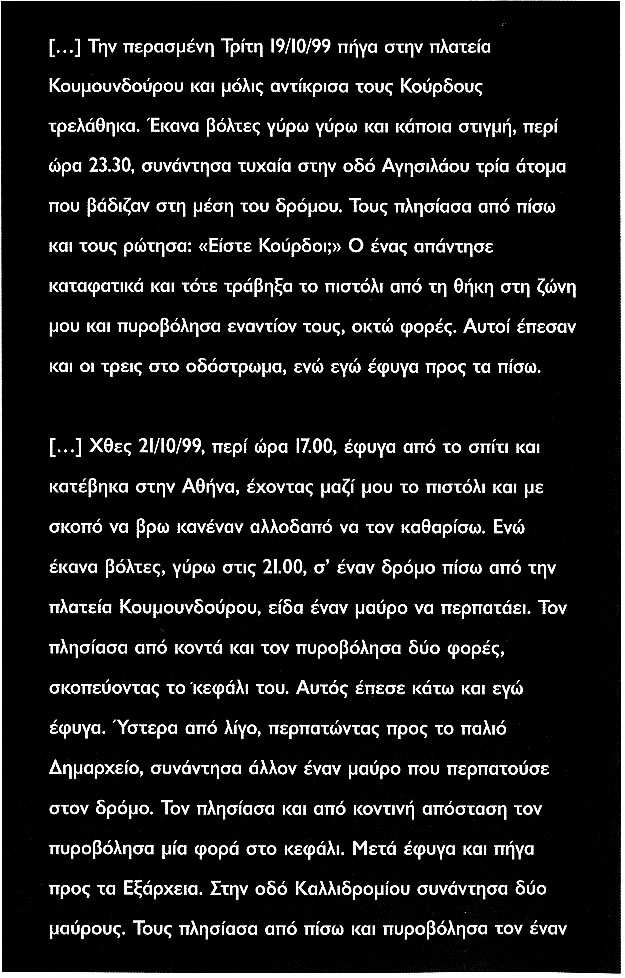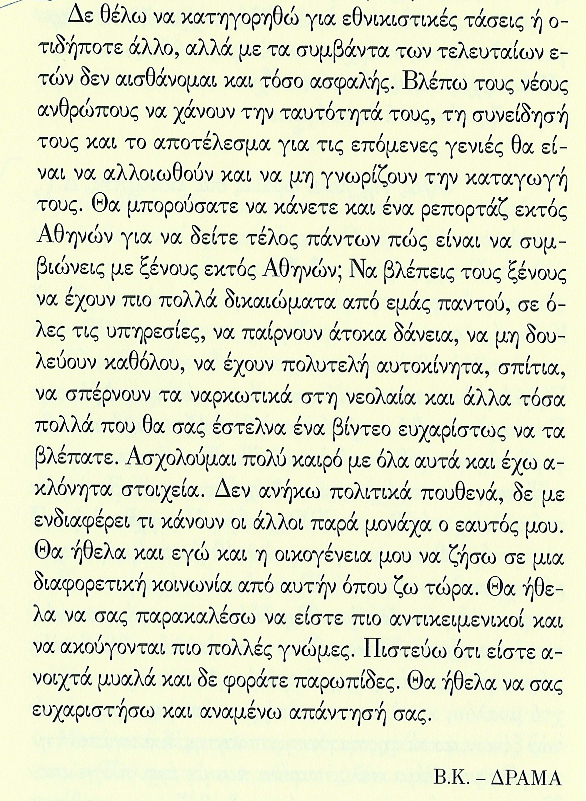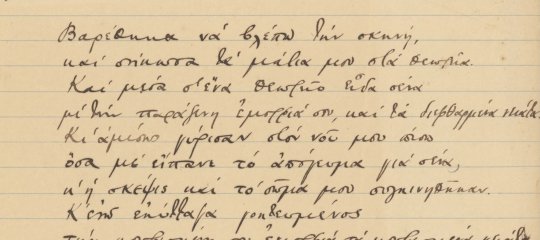Ο δρόμος για την Oμόνοια - Αρετή Πότσιου
|
Τον Οκτώβρη του 1999 ο πιστολέρο Παντελής Καζάκος τριγύριζε αλλόφρων στα σκοτεινά σοκάκια της Αθήνας και ξεπάστρευε αλλοδαπούς. Δυο από τα θύματα του επέζησαν με σοβαρές βλάβες.Ο γκανέζος Τόμι Κόφι Μάρκους ζει μέχρι σήμερα παρέα με μια σφαίρα φυτεμένη στο κεφάλι του. Κι ο νιγηριανός Τίμοθι Αμπντούλ στέκεται δύσκολα όρθιος λόγω των τριών βλημάτων που δέχθηκε στη σπονδυλική στήλη. Πέραν αυτών, η ζωή τους γίνεται ολοένα και δυσκολότερη. Υπάρχουν όμως και κάποιοι συνάνθρωποι που δεν ανέχονται αυτήν την κατάσταση κι αποφάσισαν ν' αντιδράσουν. Κάπως έτσι εκδόθηκε κι αυτό το βιβλίο, ως μια ιδέα του Σταύρου Κασιώτη. Οι είκοσι συγγραφείς κι ο εκδότης προσφέρθηκαν με χαρά και αφιλοκερδώς. Οι ιστορίες που περιλαμβάνει έχουν όλες να κάνουν με μετανάστες. Επιπλέον ο Σταύρος Θεοδωράκης μεταφέρει στο χαρτί δυο κουβέντες με τα δύο αυτά θύματα του Καζάκου. |








ΓΙΑ ΝΑ ΔΕΙΤΕ ΤΙΣ ΑΣΚΗΣΕΙΣ ΠΟΥ ΣΥΝΟΔΕΥΟΥΝ ΤΟ ΥΛΙΚΟ ΑΥΤΟ, ΕΠΙΛΕΞΤΕ ΤΗΝ ΕΠΟΜΕΝΗ ΣΕΛΙΔΑ
Ο ΔΡΟΜΟΣ ΓΙΑ ΤΗΝ ΟΜΟΝΟΙΑ
ΥΛΙΚΟ
Κατάθεση Π. Καζάκου (σελίδες σε μαύρο φόντο):
1. Αναλαμβάνει ένα απόσπασμα κάθε σπουδαστής (ή ομάδα 2 σπουδαστών) και αφηγείται στην τάξη τι έκανε αυτός ο άνθρωπος.
2. Ρωτούνται οι σπουδαστές γιατί διέπραξε αυτές τις πράξεις α) σύμφωνα με τον ίδιο τον Καζάκο και β) κατά τη δική τους γνώμη.
Γνώμες θεατών του ντοκιμαντέρ «Βρωμοέλληνες» για το θέμα των μεταναστών στην Ελλάδα. (Έχουν προηγουμένως σταλεί ηλεκτρονικά στους φοιτητές)
1. Αναφέρουν οι σπουδαστές τα επιχειρήματα που εντόπισαν στα παραπάνω αποσπάσματα υπέρ ή κατά της –αυξημένης - παρουσίας των μεταναστών στην Ελλάδα.
2. Οι σπουδαστές χωρίζονται σε ζεύγη και συντάσσουν προτάσεις συνδυάζοντας ένα θετικό στοιχείο και ένα αρνητικό, που προκύπτει από την ύπαρξη μεταναστών σε μια χώρα. Χρησιμοποιούν τους αντιθετικούς συνδέσμους, λέξεις και φράσεις που γνωρίζουν (από τη μια … από την άλλη, ωστόσο, κ.τ.λ.).
3. Εργασία για το σπίτι: να συντάξουν τρεις περιόδους, στις οποίες να συνδυάζουν ζεύγη ενός επιχειρήματος υπέρ με το αντίστοιχό του κατά της μετανάστευσης (παραδείγματα των μαθητών: Από μια άποψη είναι νέοι, κάνουν παιδιά και τονώνουν το γερασμένο πληθυσμό, από την άλλη όμως αλλάζει η σύνθεση του πληθυσμού με απρόβλεπτες συνέπειες. Προσφέρουν φτηνή εργασία, αλλά θίγονται οι οικονομικά ασθενέστερες τάξεις της χώρας. Κάνουν τις δουλειές που δεν θέλουν οι άλλοι, ωστόσο αυξάνουν την ανεργία.)
Αφήγημα Ηλία Κουτσούκου «Βρω εγκώ εσένα θέση..»
Λεξιλογική εξομάλυνση: σημασίες λέξεων και φράσεων της λαϊκής, καθημερινής γλώσσας: πρόσφυμα καρα -, αρπάζομαι, μπατζανάκης, λαμαρίνα, πού διάολο.., φτύνω αίμα, τρώω μια ώρα, μιλάμε για.., κωλοφαρδία, σπασμένα ελληνικά, τα παίρνω στο κρανίο, σώνει και καλά, δε βγάζω άχνα, βγάζω/μου βγαίνει ..(μια κακία/ρατσισμός, κτλ), γίνομαι/με κάνει αλοιφή, γίνομαι σκατά.
Συζήτηση όσον αφορά τα σημεία:
- ποιες αντίθετες απόψεις βλέπουμε μέσα στο αφήγημα
- πώς κλιμακώνεται η συμπεριφορά του αφηγητή
- τι εννοεί με την αυτοκριτική του.
Άσκηση παραγωγής προφορικού λόγου:
ετοιμάζουν οι φοιτητές ανά δύο ή τρεις έναν διάλογο (με 4-5 ερωταποκρίσεις) που ξεκινά με μία από τις επόμενες ερωτήσεις: πότε είδες τελευταία φορά μπροστά σου μια ρατσιστική συμπεριφορά; Θυμάσαι μια δική σου συμπεριφορά που νομίζεις πως ήταν ρατσιστική; Τι κάνεις όταν ακούς να λένε κάτι ρατσιστικό μπροστά σου; Σου έχουν φερθεί ποτέ ρατσιστικά για κάποιο λόγο; κ.ά. Αναπαριστούν στην τάξη το διάλογο που συνέθεσαν.
Εργασία για το σπίτι (με τη βοήθεια λεξικού και σωμάτων κειμένων):
να γράψουν 5 προτάσεις χρησιμοποιώντας κάθε φορά μία από τις λαϊκές ή αργκό εκφράσεις του αφηγήματος.
Στο επόμενο μάθημα:άσκηση αντιστοίχισης (περισσεύουν 6 σημασίες) για όσους δεν έχουν καταλάβει ακόμη καλά τη σημασία τους:
1 αρπάζομαι εννοώ
2 μπατζανάκης
3 λαμαρίνα
4 πού διάολο..;
5 φτύνω αίμα
6 τρώω μια ώρα
7 μιλάμε για..
8 κωλοφαρδία
9 σπασμένα ελληνικά
10 τα παίρνω στο κρανίο
11 σώνει και καλά
12 δε βγάζω άχνα
13 βγάζω/μου βγαίνει ..(μια κακία)
14 γίνομαι/με κάνει (κάποιος /κάτι)
15 γίνομαι σκατά
εννοώ (με έμφαση και προσωπική άποψη)
αυτοκίνητο
πεινάω
τρώω πολύ, χορταίνω
συγγενής εξ αγχιστείας
οπωσδήποτε
καθυστερώ
τύχη
κατανοώ
καταφέρνω, κατορθώνω
επιτατική ερωτημ. έκφραση αρνητικών ή θετικών συναισθημάτων (θυμού, θαυμασμού, κ.ά)
δυσκολεύομαι, κουράζομαι πολύ
όπως μιλάει ένας που δεν τα ξέρει καλά
θυμώνω ξαφνικά, εξοργίζομαι
δε θέλω τίποτα
νιώθω πολύ συγκινημένος και ευάλωτος από τη συμπεριφορά κάποιου
αισθάνομαι τιποτένιος, άθλιος
μαλώνω, θυμώνω
ταλαιπωρούμαι πολύ
μου βγαίνει η Παναγία /το λάδι
Σε ένα επόμενο μάθημα (Τετάρτη, όταν έχουμε στην αίθουσα προβολέα (κανονάκι) και μεγαλύτερη οθόνη) έπεται η προβολή της ταινίας του Σ. Γκορίτσα «Απ’ το χιόνι».
Αρετή Πότσιου











 Τα έσοδα θα διατεθούν για τις ανάγκες των Τίμοθι και Τόμι.
Τα έσοδα θα διατεθούν για τις ανάγκες των Τίμοθι και Τόμι.